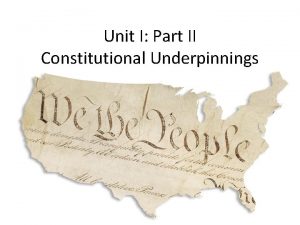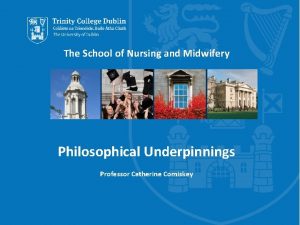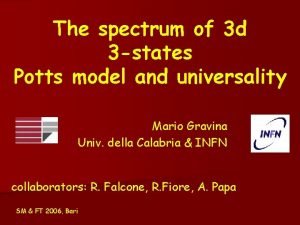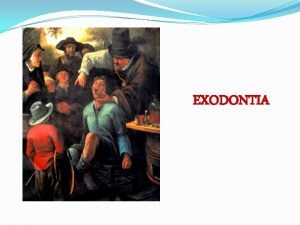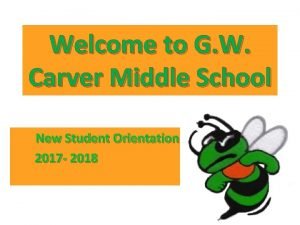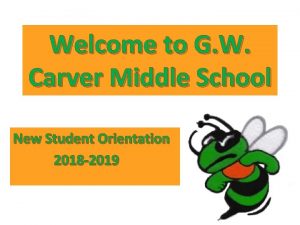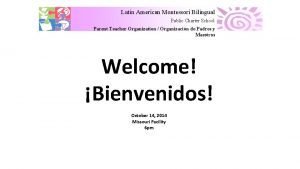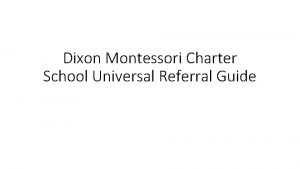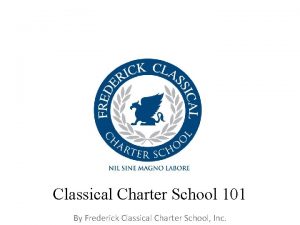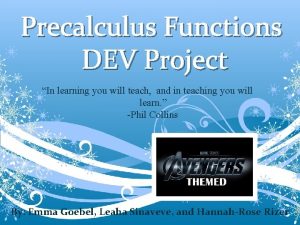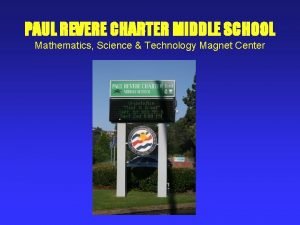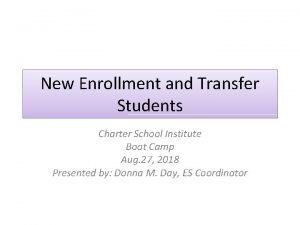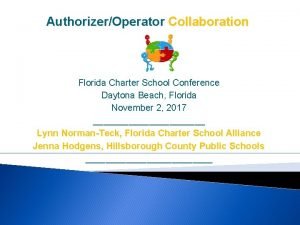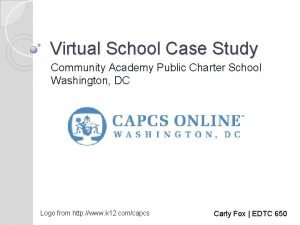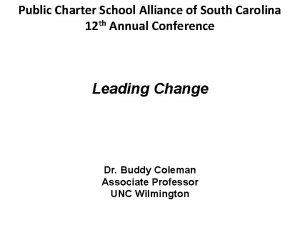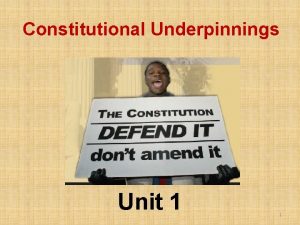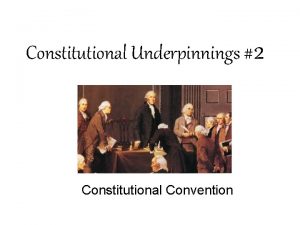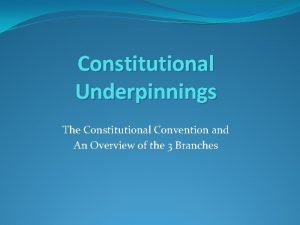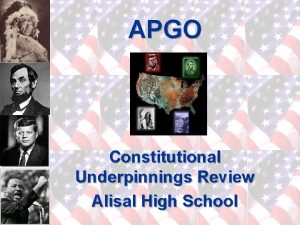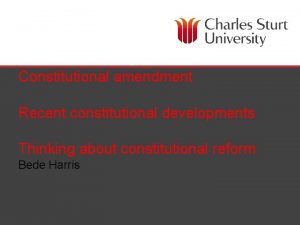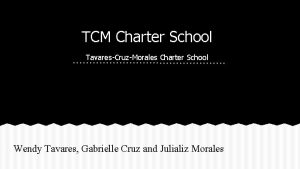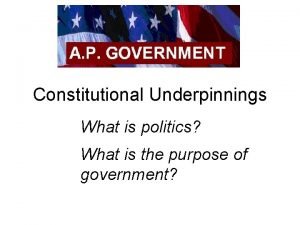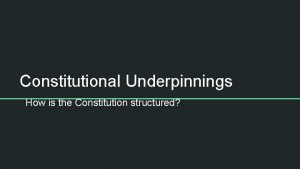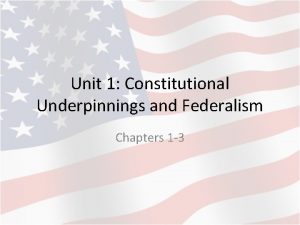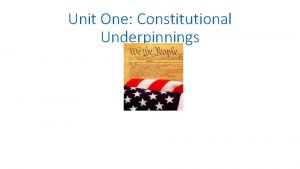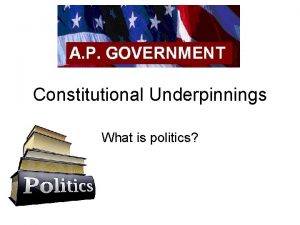Constitutional Underpinnings Jamey Potts Miami Arts Charter School






































- Slides: 38

Constitutional Underpinnings Jamey Potts Miami Arts Charter School Honors US Government and Politics 8/30/2018

Inspirations of the Formation of the United States Constitution-Enlightenment Thinkers • John Locke (1632 -1704)-Born in England • Natural rights- people are born with the right to life, liberty, and property • Social contract- an agreement between the government and its people. Government should preserve people’s natural rights. • Consent of the governed- if the government does not preserve people’s natural rights, the people have the power to overthrow the government. • Charles de Montesquieu (1689 -1755)-Born in France • Established the idea of a separation of powers-legislative, executive, and judicial. • A system of divided authority would protect the rights of individuals by preventing one branch of government from gaining unrestricted control over the entire society. • “We can not find abuse of power, must, by the arrangement of things, power checks power. ” • “There is as yet no liberty if the power of judging be not separated from legislative power and the executive power”

Inspirations of the Formation of the United States Constitution-Colonial Experiences • French and Indian War (1756 -1763)- British colonies fighting the French in the North (Canada) and the Spanish in the South. Overall, English victory--- their troops ended the French presence in Canada and Florida was taken from Spain. 1. Consequence of F&IW- British victory was costly—the king and Parliament thought the colonies should help pay for the war.

Inspirations of the Formation of the United States Constitution-Colonial Experiences • Stamp Act (1765)- required everyone to pay a fee for an official stamp for all contracts, other official documents, and even newspapers. • Sugar Act (1764), Townshend Act (1767) • Colonists refused to pay, not because they didn’t somewhat agreed that they should help pay the war debt, but because they had no representation, and therefore no say in the taxes levied. • The Boston Massacre (1770) made a lot of people start supporting separation from Britain. • Boston Tea Party (1772)- led to Britain implementing Coercive/Intolerable Acts (1774) • 2. Consequence Coercive/Intolerable Acts (1774) of public colonial support for separation from Britain.

Inspirations of the Formation of the United States Constitution-Colonial Experiences • Declaration of Independence (1776) – written by Thomas Jefferson, inspired by John Locke. • Lays out theory of government based on social contract (agreement between the people and their government) and natural rights. • Lists grievances of British government’s rule over the colonies. • Calls for unity of the colonies and separation from Britain.

Inspirations of the Formation of the United States Constitution-Articles of Confederation • Written by the Second Continental Congress in 1777. • When it was written, the leaders needed to figure out how to organize the new country and how to form a government to fight England. • A good thing- The AOC granted Congress the power to authorize the Revolutionary War. • Established a “firm league of friendship” among the stateseach state retained its “sovereignty, freedom, and independence”. • Weak national government • Unicameral Congress-each state had one vote • One branch- legislative. There were no executive or judicial branches.

Inspirations of the Formation of the United States Constitution-Articles of Confederation

Inspirations of the Formation of the United States Constitution-Articles of Confederation • Shays’s Rebellion (1786)- the catalyst that led to the Constitutional Convention. • Farmers in Massachusetts were struggling financially and were losing their land. • They assembled to protest state policies that were hurting them. • They demanded an increased circulation of paper money to be able to pay their debts, as well as an end to foreclosures & heavy taxation. • They forced several judges to close their courts. • Leaders (of the US government) realized that the AOC were too weak and that the US needed a stronger central government that could maintain order, protect property, and promote commerce.

The Formation of the United States Constitution-The Constitutional Convention • Constitutional Convention (May 1787)- Imagine a super hot, smoky room in Philadelphia, full of white haired men, convening with the purpose of revising the Articles of Confederation. • 12 of the 13 states sent delegates. Rhode Island was absent. • The delegates included 7 former or current governors, 33 lawyers, 34 college graduates, and 8 signers of the Declaration of Independence. • Less than one week after the Convention began the delegates threw away the Articles of Confederation in favor of starting over. GOAL---a Constitution with a much stronger central government. • First thing----REPRESENTATION

The Formation of the United States Constitution-The Constitutional Convention • The issue of representation at the CC---YOU MUST KNOW • Virginia Plan • New Jersey Plan

The Formation of the United States Constitution-The Constitutional Convention • The issue of representation at the CC---YOU MUST KNOW • Connecticut Compromise

The Formation of the United States Constitution-The Constitutional Convention • The issue of representation at the CC---YOU MUST KNOW • 3/5 Compromise

The Formation of the United States Constitution-The Constitutional Convention

The United States Constitution-economic power • Framers agreed that there needed to be a strong central government to promote economic growth and protect private property. • Provisions in the Constitution allowed for an increase in the economic power of the central government. • Congress was given the power to • • • Obtain revenue through taxing Pay debts Coin money and regulate its value Establish uniform laws of bankruptcy Punish counterfeiting

The United States Constitution-individual rights • Also important to the Framers was the safeguarding of individual rights. The Bill of Rights, which ensured fundamental liberties did not come around until 1791 (the BOR was not part of the original Constitution—they were the first 10 AMENDMENTS) • The original Constitution includes the following protections of individual rights. • • • It prohibits suspension of habeas corpus It prohibits bills of attainder It prohibits ex post facto laws It upholds the right to trial by jury in criminal cases It prohibits the imposition of religious qualifications for holding office

The United States Constitution-The 5 Basic Principles of American Government • 1. Popular sovereignty- the people are the source of the government’s authority • 2. Limited Government-belief that the government is not all powerful; government only has those powers given to it • 3. Separation of Powers- each branch of government has its own powers and is independent of and equal to other branches. • 4. Checks and Balances- each branch is subject to restraints by the other two branches. • 5. Federalism- a division of governmental powers between the national government and the states.

The United States Constitution-The Debate over Ratification • Ratification needed to happen---to ratify=to officially approve • The delegates of the Constitution signed in in September 1787, but 9 out of 13 states had to ratify it before it became law. • Debate over ratification was split into two groups • Federalists- supported a stronger central government with expanded legislative powers. • Included large landowners, wealthy merchants, professionals • Promised to add amendments specifically protecting individual liberties • Anti-Federalists- supported stronger state governments and a weak national government • Included small farmers, shopkeepers, and laborers • Called for a Bill of Rights to protect individual liberties

The United States Constitution-The Federalist Papers • A series of 85 essays written by Alexander Hamilton, James Madison, and John Jay in support of ratification of the Constitution. • Federalist #10 - political factions are undesirable but inevitable. • Madison believed that majority rule is one of the hallmarks of a democratic society, however they feared that majorities could abuse their power and therefore threaten the stability of the new government. • Example: Shays’s Rebellion

The United States Constitution-Checks and Balances- Each branch is subject to restraints by the other two branches.

The United States Constitution-Checks and Balances- Each branch is subject to restraints by the other two branches.

The United States Constitution-Checks and Balances- Each branch is subject to restraints by the other two branches.

The United States Constitution-Formal Amendment Process • Written changes to the Constitution. They add to, change the wording of, or delete language from the Constitution. There have only been 27 amendments ratified total. The first 10 were the Bill of Rights (1791).

The United States Constitution-Informal Amendment Process • Do not involve changing the language of the Constitution. • Legislative actions-laws that clarify and expand constitutional provisions • Judiciary Act of 1789 -began the process of creating the federal court system we have today. • Executive actions-presidents use their power to expand authority • Executive agreements- instead of treaties, allows the president to bypass the Senate • Judicial review- not mentioned in the Constitution. • Marbury v. Madison (1803)

The United States Constitution-List of Amendments

The United States Constitution-The Basis of Federalism • The Three Systems of Government • Unitary- A centralized system of government in which all power is vested in a central government. • Examples- Great Britain, France, China • Confederate- A decentralized system of government in which a weak central government has limited power over the states. • Examples- the U. S. under the Articles of Confederation, United Nations • Federal- A system of government in which a power is divided by a written constitution between a central government and regional governments. • Examples- the U. S. , Mexico, Canada, Germany

The United States Constitution-The Basis of Federalism • The Framers chose to balance order and freedom by creating a federal system that assigned powers to the national government while reserving other powers to the states. • Why not unitary? –Revolution was fought against a distant central government in London. • Why not confederate? – The Articles of Confederation proved to be too weak. Founders believed that the new nation had a lot of problems and it needed a stronger central government to solve them.

The United States Constitution-The Basis of Federalism • The term federalism is not found in the US Constitution. • However, it is clearly defined in the enumerated, concurrent, and reserved power of the national and state governments. • Enumerated/Expressed/Delegated powers- those specifically given to the national government. • Implied powers- although not expressed, powers that may be reasonably inferred from the Constitution (Article I, Section 8, Clause 18 - the Necessary and Proper Clause aka the Elastic Clause).

The United States Constitution-The Basis of Federalism • Inherent powers- powers that exist for the national government because the government is sovereign. • Concurrent powers- powers that are shared by both the national and state governments. • Reserved powers- powers belonging specifically to the states because they were neither delegated to the national government nor denied to the states (Article IV; Amendment 10) • Prohibited powers- powers that are denied to the national government, state governments, or both (Article I, Sections 9 & 10; Amendments).

The United States Constitution-The Basis of Federalism

Mc. Culloch v. Maryland & “Implied Powers”

Mc. Culloch v. Maryland (1819) & the “Supremacy Clause” • Article IV of the US Constitution contains the Supremacy Clause. • The Supremacy Clause helps to resolve conflicts between national and state laws. • It states that the US Constitution, its laws and treaties shall be the “supreme law of the land”. • In the case of Mc. Culloch v. Maryland, the Court held that the Maryland law was unconstitutional because it violate dthe principle of the supremacy of the national government over the states. US > Maryland. It declared that states cannot interfere with or tax the legitimate activities of the federal government. • This ruling established the implied powers of the national government and national supremacy, the basis used to strengthen the power of the national government.

Gibbons v. Ogden (1824) & the “Commerce Clause” • The New York legislature gave Robert Livingston and Robert Fulton exclusive rights to operate steamboats in New York waters and Aaron Ogden the right to operate a ferry between New York and New Jersey. • Thomas Gibbons had received a national government license to operate boats in interstate waters. • Ogden sued Gibbons and won in the New York courts; Gibbons appealed to the Supreme Court. The Marshall court defined commerce as including all business dealings, and the power to regulate interstate commerce belongs exclusively to the national government. • Today, the national government uses the commerce clause to justify the regulation of numerous areas of economic activity. • The Supreme Court used the Commerce Clause to uphold the Civil Rights Act of 1964.

Different Types of Federalism • Dual Federalism/Layer Cake Federalism (1789 -1932)

Different Types of Federalism • Cooperative Federalism/Marble Cake Federalism (1930 s -present)

Types of Federalism • Devolution- a movement to transfer responsibilities of governing from the federal government to state and local governments. • Example- Welfare Reform Act of 1996 gave the states the money to run their own welfare programs.

Types of Federalism • Fiscal Federalism- The national government’s patterns of spending, taxation, and providing grants to influence state and local governments. • The national government uses fiscal policy to influence the states through granting or withholding money to pay for programs. • Types of federal grants • Categorical grants- money given to the states for a SPECIFIC purpose. These increase the power of the federal government because states must comply with the attendant regulations. • Example-school lunch programs, sewage treatment facilities • Block grants- General grants that can be used for a broad purpose. States have greater discretion in making decisions about how to implement a program. • Example-education, health care, public services

Types of Federalism • Fiscal Federalism- The national government’s patterns of spending, taxation, and providing grants to influence state and local governments. • Mandates- requirements that are imposed by the national government on the state and local governments; for example, the Americans with Disabilities Act (1990) mandates that all public buildings be accessible to persons with disabilities. Mandates often require state or local governments to meet the requirement at their own expense (unfunded mandates). • After the mid-term elections of 1994, the Republicancontrolled Congress passed the Unfunded Mandate Reform Act, which imposed limitations on Congress’s ability to pass unfunded mandate legislation.

Federalism
 Federalism ap gov
Federalism ap gov Philosophical underpinnings of nursing
Philosophical underpinnings of nursing Charterbare
Charterbare Principle of elevators
Principle of elevators Adrian potts
Adrian potts Lynn potts md
Lynn potts md 9 box talent review
9 box talent review Potts
Potts Colin potts gatech
Colin potts gatech Wedge principle of elevators
Wedge principle of elevators Creative arts grade 7 lesson plan term 2
Creative arts grade 7 lesson plan term 2 Carver middle school dress code
Carver middle school dress code Carver dress code
Carver dress code Carver dress code
Carver dress code Smsh miami
Smsh miami Miami sunset senior high football
Miami sunset senior high football Miami killian senior high school rating
Miami killian senior high school rating Miami beach senior high scholars program
Miami beach senior high scholars program Latin american montessori bilingual public charter school
Latin american montessori bilingual public charter school Lead nurturing for charter schools
Lead nurturing for charter schools Dixon montessori charter school
Dixon montessori charter school What is education
What is education Cape coral charter school authority
Cape coral charter school authority Nyos charter school shooting
Nyos charter school shooting Paul revere ms
Paul revere ms Imagine school hemet
Imagine school hemet Brass city charter school
Brass city charter school Chatsworth senior high school
Chatsworth senior high school National charter school resource center
National charter school resource center Charter school institute
Charter school institute Zenobia cann
Zenobia cann Community academy public charter school
Community academy public charter school Queen city academy charter school
Queen city academy charter school Sierra nevada academy charter school
Sierra nevada academy charter school Raleigh charter high school lisa huddleston
Raleigh charter high school lisa huddleston Pinecrest academy south charter school
Pinecrest academy south charter school Sculptor charter
Sculptor charter Charter school sixth form
Charter school sixth form Public charter school alliance of south carolina
Public charter school alliance of south carolina
